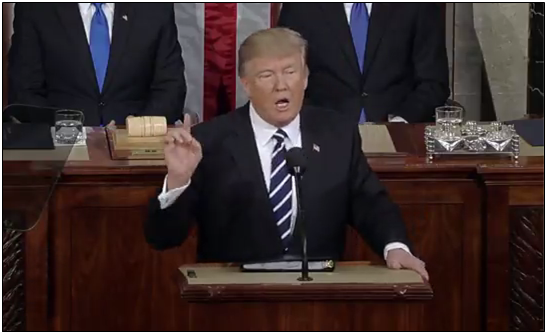It would appear President Donald Trump has not forgotten the political coalition that got him elected in 2016, with his first State of the Union Address reaching out to key constituencies that made the difference in the swing states of Florida, North Carolina, Ohio, Michigan, Pennsylvania and Wisconsin.
It was the combination of union and conservative households, particularly in the Rust Belt, that responded to Trump’s populist appeals on trade, illegal immigration and jobs for Americans. In that sense, Trump owes his presidency very much to certain traditionally Democrat constituencies. Blue collar workers clearly provided that advantage.
Unsurprisingly, those issues were once again on display as Trump outlined his agenda for Congress.
On trade, Trump played to his strengths with those voters, stating, “I believe strongly in free trade but it also has to be fair trade. It’s been a long time since we had fair trade… I am not going to let America and its great companies and workers be taken advantage of us any longer. They have taken advantage of our country. No longer. I am going to bring back millions of jobs.” He noted he had already terminated “the job-killing Trans-Pacific Partnership.”
Other issues with a similar appeal were the building of the Keystone XL and Dakota Access pipelines — which he promised would be made with American steel — and the push to revitalize the U.S. military and American infrastructure.
Trump more or less stuck to his guns promoting his immigration reform agenda, including building a southern border wall, enforcing existing laws and ending the chain migration system in favor of a merit-based system.
It catered also to Trump’s natural advantage among males. The way Trump defeated the gender gap was by creating one of his one. For example, in the pivotal state of Pennsylvania, Trump won 57 percent of males, compared with Hillary Clinton only winning 55 percent of females, according the CNN exit poll. Similar trends played out in Michigan, Ohio and Wisconsin.
And don’t forget Millennials, particularly older Millennials where Trump defied expectations. In Michigan, Trump actually won narrowly among 30 to 39 year olds, 46 percent to 45 percent — likely on the strength of his Trump’s jobs message.
There were other familiar appeals from 2016 in the speech that strike at the heart of the Democrats’ traditional voting constituencies. Trump continued with his campaign to Black Americans, promoting restoring inner cities, promising to restore law and order, institute school choice and create new opportunities for jobs.
Of course, it was not swing voters alone who won the day on Nov. 8.
For conservatives and Republicans, too, there was a lot in the speech, including strengthening the military including properly taking care of veterans, restoring law and order, his immigration stance, the deregulation agenda, defeating radical Islamic terrorism, providing tax relief, promoting constitutionalists to the federal judiciary and repealing and replacing Obamacare.
To the extent that Trump delivers on all of his promises, then, a huge opportunity exists for Trump — and Republicans — to expand their coalition in 2018 and 2020. The GOP might not have a better opportunity to implement a Republican president’s agenda.
Robert Romano is the senior editor of Americans for Limited Government.







